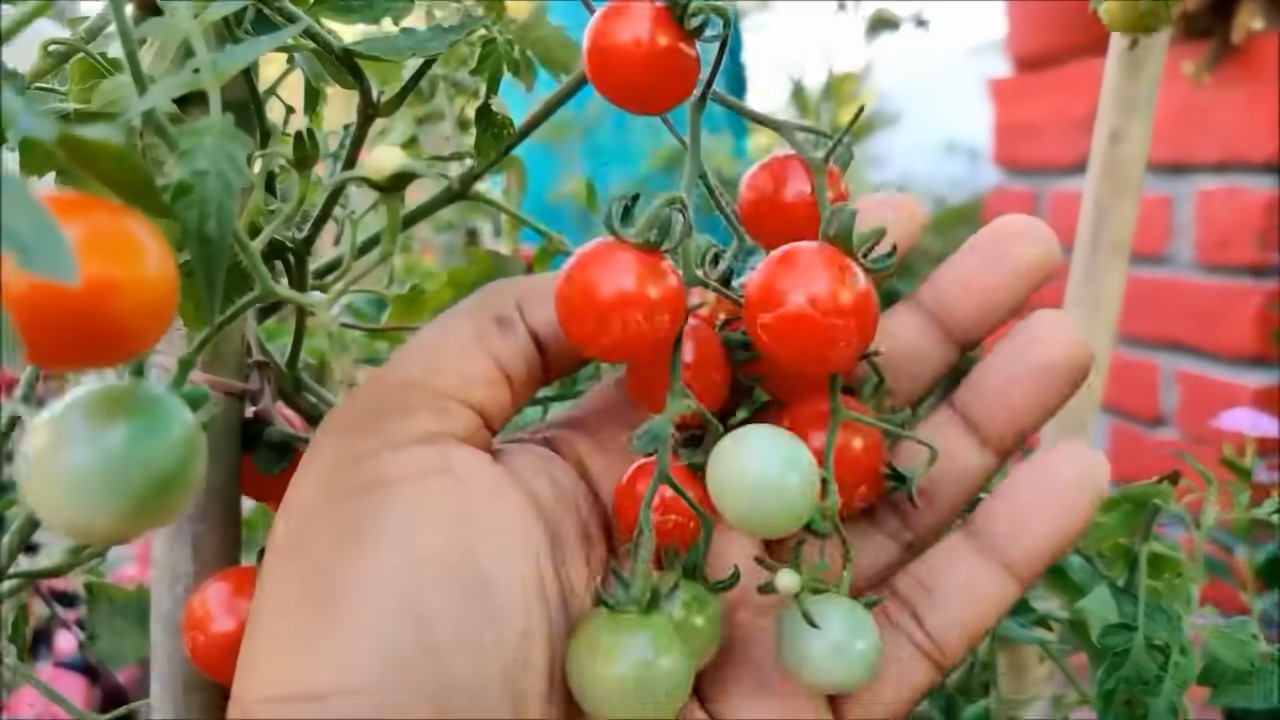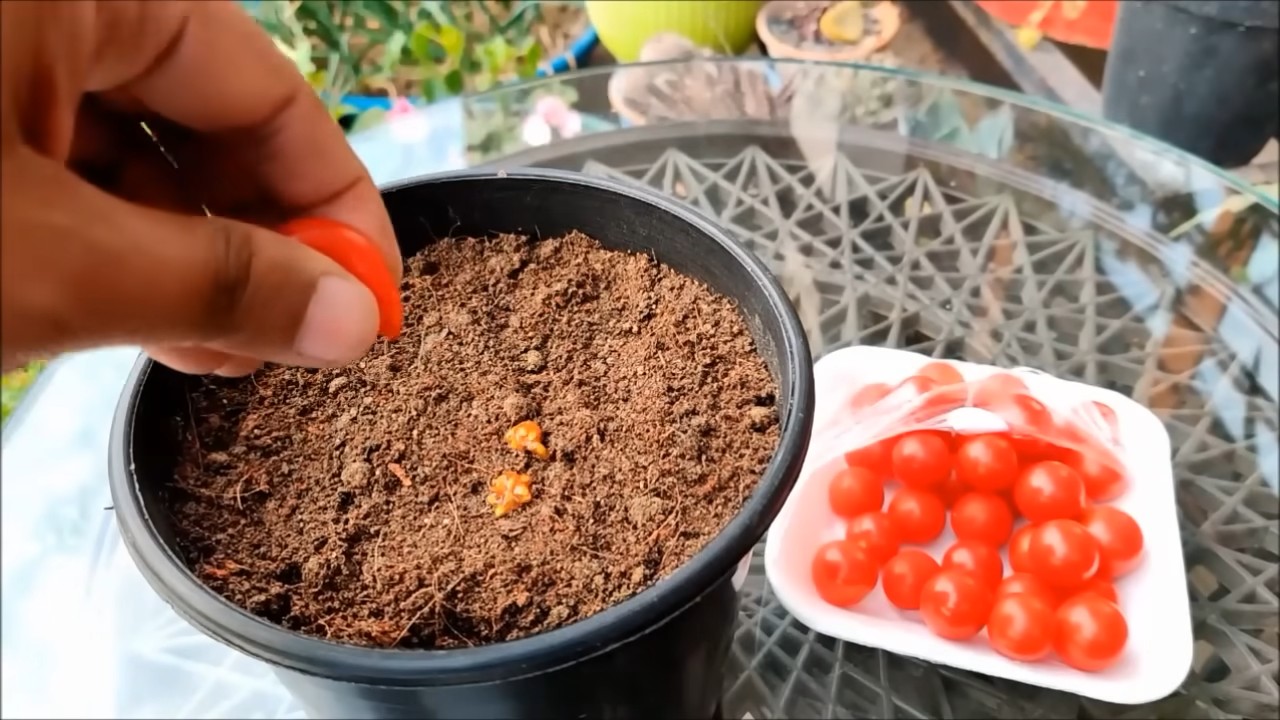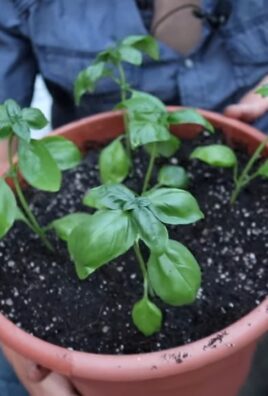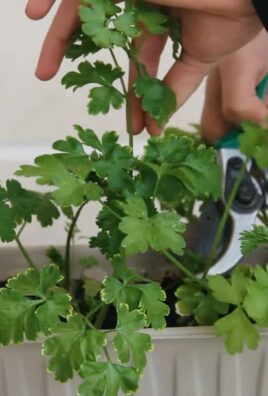Grow Cherry Tomatoes at Home – imagine plucking juicy, sun-ripened cherry tomatoes straight from your own backyard! There’s nothing quite like the burst of flavor from a homegrown tomato, and trust me, it’s easier than you think to cultivate these little gems yourself. For centuries, tomatoes, originating from South America, have been a staple in gardens and kitchens worldwide, evolving from ornamental plants to culinary superstars.
But let’s be honest, sometimes gardening feels like a battle against pests, unpredictable weather, and just plain lack of space. That’s where these DIY tricks and hacks come in! I’m going to share some simple, effective methods to help you grow cherry tomatoes at home, even if you’re a beginner or have limited space.
Think about it: fresh salads, vibrant snacks, and the satisfaction of knowing exactly where your food comes from. Plus, avoiding those bland, store-bought tomatoes is a huge win! So, ditch the grocery store and get ready to transform your balcony, patio, or garden into a cherry tomato paradise. Let’s dive into these easy DIY secrets and get those tiny tomatoes thriving!

Growing Cherry Tomatoes at Home: A Beginner’s Guide
Okay, so you want to grow your own juicy, sweet cherry tomatoes right at home? Awesome! It’s easier than you think, and there’s nothing quite like popping a sun-warmed, homegrown tomato into your mouth. I’m going to walk you through everything you need to know, from choosing the right variety to harvesting your bounty. Let’s get started!
Choosing Your Cherry Tomato Variety
First things first, you need to decide what kind of cherry tomato you want to grow. There are tons of options, each with its own unique flavor, size, and color. Here are a few popular choices:
- Sungold: These are super sweet and have a beautiful golden-orange color. They’re a favorite for a reason!
- Sweet Million: As the name suggests, these produce a huge amount of small, red, and very sweet tomatoes.
- Black Cherry: These have a rich, complex flavor and a deep, almost black color. They’re a bit more unique and definitely worth trying.
- Grape Tomatoes: These are smaller and more oblong than traditional cherry tomatoes, with a slightly firmer texture. They’re great for snacking.
- Yellow Pear: These are shaped like tiny pears and have a mild, slightly tangy flavor. They’re also very visually appealing.
Consider what you’ll be using the tomatoes for. Snacking? Salads? Sauces? This will help you narrow down your choices. I personally love Sungolds for their sweetness and Sweet Millions for their sheer productivity.
Starting Your Seeds (or Buying Seedlings)
You have two main options here: starting your own seeds indoors or buying seedlings from a nursery. Starting from seed gives you more control over the variety and can be more cost-effective, but it requires a bit more time and effort. Buying seedlings is quicker and easier, but you’ll be limited to what the nursery has available.
Starting Seeds Indoors:
If you’re going the seed route, here’s what you’ll need:
- Seeds: Obviously! Choose a reputable seed supplier.
- Seed starting mix: This is a special soil mix that’s lightweight and sterile, perfect for delicate seedlings. Don’t use regular garden soil.
- Seed starting trays or small pots: You can use plastic trays with individual cells or small peat pots.
- Humidity dome (optional): This helps keep the soil moist and warm, which is ideal for germination.
- Grow lights (optional but recommended): Seedlings need a lot of light to grow strong and healthy. A grow light will ensure they get enough.
- Spray bottle: For gently watering the seedlings.
Now, let’s get planting!
- Sow the seeds: Fill your seed starting trays or pots with seed starting mix. Moisten the mix with water. Sow 2-3 seeds per cell or pot, about 1/4 inch deep.
- Cover and water: Gently cover the seeds with more seed starting mix. Lightly mist the surface with water using a spray bottle.
- Provide warmth and humidity: If you have a humidity dome, place it over the trays. Otherwise, you can cover them with plastic wrap. Place the trays in a warm location (around 70-75°F).
- Provide light: If you’re using grow lights, position them a few inches above the trays. If not, place the trays in a sunny window, but be aware that seedlings may become leggy (tall and spindly) without enough light.
- Water regularly: Keep the soil consistently moist, but not soggy. Check the soil moisture daily and water as needed.
- Remove the humidity dome: Once the seeds germinate (usually within 5-10 days), remove the humidity dome.
- Thin the seedlings: Once the seedlings have their first true leaves (the second set of leaves that appear after the initial seed leaves), thin them to one seedling per cell or pot. Choose the strongest, healthiest-looking seedling and snip off the others at the soil line.
Buying Seedlings:
If you’re buying seedlings, look for plants that are healthy, stocky, and have a good green color. Avoid plants that are leggy, yellowing, or have any signs of disease or pests.
Preparing Your Garden Bed or Containers
Whether you’re growing your cherry tomatoes in the ground or in containers, proper soil preparation is crucial.
In the Garden:
- Choose a sunny location: Cherry tomatoes need at least 6-8 hours of sunlight per day.
- Prepare the soil: Amend the soil with plenty of compost or other organic matter. This will improve drainage, fertility, and water retention.
- Check the soil pH: Cherry tomatoes prefer a slightly acidic soil pH of around 6.0-6.8. You can test your soil pH with a soil testing kit. If the pH is too high, you can lower it by adding sulfur or peat moss.
In Containers:
- Choose the right size container: Cherry tomatoes need a container that’s at least 12 inches in diameter and 12 inches deep. Larger is better!
- Use a good quality potting mix: Don’t use garden soil in containers, as it will compact and drain poorly. Choose a potting mix that’s specifically designed for containers.
- Ensure good drainage: Make sure your container has drainage holes to prevent waterlogging.
Transplanting Your Seedlings
Once your seedlings are about 6-8 inches tall and the weather is warm enough (no danger of frost), it’s time to transplant them into your garden or containers.
- Harden off the seedlings: Before transplanting, you need to harden off the seedlings. This means gradually exposing them to outdoor conditions over a period of 7-10 days. Start by placing them outside in a sheltered location for a few hours each day, gradually increasing the amount of time they spend outdoors.
- Prepare the planting holes: Dig holes that are slightly larger than the root balls of the seedlings. Space the plants about 2-3 feet apart.
- Plant the seedlings: Gently remove the seedlings from their pots or trays. If the roots are pot-bound (tightly circling the pot), gently loosen them before planting. Place the seedlings in the holes and backfill with soil.
- Water thoroughly: Water the seedlings thoroughly after planting.
- Add support: Cherry tomatoes can get quite tall and heavy, so it’s important to provide them with support. You can use stakes, cages, or trellises. I prefer cages because they provide all-around support.
Caring for Your Cherry Tomato Plants
Now that your cherry tomato plants are in the ground, it’s time to give them the care they need to thrive.
- Watering: Water your cherry tomato plants regularly, especially during hot, dry weather. Aim to water deeply and less frequently, rather than shallowly and more often. Water at the base of the plant to avoid wetting the foliage, which can lead to disease.
- Fertilizing: Cherry tomatoes are heavy feeders, so they need regular fertilization. Use a balanced fertilizer that’s specifically formulated for tomatoes. Follow the instructions on the fertilizer package. I like to use a slow-release fertilizer at planting time and then supplement with a liquid fertilizer every few weeks.
- Pruning: Pruning can help improve air circulation and encourage fruit production. Remove any suckers (the small shoots that grow between the main stem and the branches). You can also remove any yellowing or diseased leaves.
- Pest and disease control: Keep an eye out for pests and diseases. Common pests include aphids, tomato hornworms, and whiteflies. Common diseases include early blight, late blight, and blossom end rot. There are many organic and conventional methods for controlling pests and diseases. I prefer to use organic methods whenever possible.
- Mulching: Mulching can help conserve moisture, suppress weeds, and regulate soil temperature. Use organic mulch such as straw, hay, or wood chips.
Dealing with Common Problems
Even with the best care, you may encounter some problems along the way. Here are a few common issues and how to address them:
- Blossom end rot: This is a condition where the bottom of the tomato turns black and leathery. It’s caused by a calcium deficiency, which is often due to inconsistent watering. Make sure to water your plants regularly and deeply. You can also add calcium to the soil by adding crushed eggshells or bone meal.
- Early blight: This is a fungal disease that causes dark spots on the leaves.

Conclusion
So, there you have it! Growing cherry tomatoes at home is not only achievable, but it’s also incredibly rewarding. Forget those bland, store-bought tomatoes that lack that burst of sunshine flavor. With a little effort and this straightforward DIY trick, you can cultivate your own supply of sweet, juicy cherry tomatoes right in your backyard, balcony, or even on a sunny windowsill.
Why is this a must-try? Because it puts you in control. You choose the variety, you control the growing conditions, and you reap the benefits of fresh, organic produce. Imagine the satisfaction of plucking a perfectly ripe cherry tomato straight from the vine and popping it into your mouth. Think of the delicious salads, sauces, and snacks you can create with your homegrown bounty. Plus, it’s a fantastic way to connect with nature and learn about the growing process.
But the best part? This DIY method is adaptable. Want to experiment? Try different varieties of cherry tomatoes! Yellow pear tomatoes, black cherry tomatoes, or even the classic red cherry tomatoes – the possibilities are endless. You can also adjust the container size to fit your space. If you’re short on room, a hanging basket works wonders. For a larger yield, opt for a bigger pot.
Consider companion planting to enhance your tomato’s growth and flavor. Basil is a classic pairing, known to improve the taste of tomatoes and deter pests. Marigolds are another excellent choice, helping to repel nematodes and other harmful insects.
Don’t be afraid to get creative with your support system. While tomato cages are readily available, you can also use stakes, trellises, or even repurposed materials like old ladders or branches to provide support for your growing vines.
And remember, consistent watering and fertilization are key to success. Monitor your plants regularly for signs of pests or diseases, and address any issues promptly. A little bit of attention goes a long way in ensuring a healthy and productive harvest.
We wholeheartedly encourage you to give this DIY trick a try. It’s a fun, educational, and ultimately delicious experience. And once you’ve tasted the difference between homegrown and store-bought, you’ll never go back.
So, grab your seeds, soil, and a sunny spot, and get ready to embark on your cherry tomato growing adventure. We’re confident that you’ll be amazed by the results.
Most importantly, we want to hear about your experience! Share your photos, tips, and stories with us in the comments below. Let’s create a community of home gardeners and inspire others to grow their own food. What variety did you choose? What challenges did you face? What successes did you celebrate? Your insights can help others learn and grow, too. Let’s all learn to grow cherry tomatoes at home!
Frequently Asked Questions (FAQ)
What is the best time to start growing cherry tomatoes?
The ideal time to start growing cherry tomatoes depends on your climate. In general, you should start seeds indoors 6-8 weeks before the last expected frost. If you live in a warmer climate with a longer growing season, you can start seeds directly outdoors after the last frost has passed. However, starting indoors gives your plants a head start and allows them to mature more quickly. Check your local weather forecasts and gardening resources to determine the best planting time for your specific region.
What kind of soil is best for cherry tomatoes?
Cherry tomatoes thrive in well-draining, nutrient-rich soil. A loamy soil that is slightly acidic (pH 6.0-6.8) is ideal. You can improve your soil by adding compost, aged manure, or other organic matter. These amendments will help to improve drainage, aeration, and nutrient content. Avoid heavy clay soils, as they can become waterlogged and inhibit root growth. If you’re growing in containers, use a high-quality potting mix specifically formulated for vegetables.
How much sunlight do cherry tomatoes need?
Cherry tomatoes require at least 6-8 hours of direct sunlight per day to produce a bountiful harvest. Choose a location that receives plenty of sunlight throughout the day. If you’re growing indoors, place your plants near a sunny window or use grow lights to supplement natural light. Insufficient sunlight can lead to leggy growth, reduced flowering, and smaller, less flavorful tomatoes.
How often should I water my cherry tomato plants?
Water your cherry tomato plants deeply and regularly, especially during hot, dry weather. Aim to keep the soil consistently moist but not waterlogged. Water at the base of the plant to avoid wetting the foliage, which can increase the risk of fungal diseases. Check the soil moisture regularly by sticking your finger into the soil about an inch deep. If the soil feels dry, it’s time to water. Container-grown tomatoes may need to be watered more frequently than those grown in the ground.
What kind of fertilizer should I use for cherry tomatoes?
Cherry tomatoes benefit from regular fertilization throughout the growing season. Use a balanced fertilizer with equal amounts of nitrogen, phosphorus, and potassium (e.g., 10-10-10) when planting. Once the plants start to flower and produce fruit, switch to a fertilizer that is higher in phosphorus and potassium (e.g., 5-10-10) to promote fruit development. Follow the instructions on the fertilizer package for application rates. You can also use organic fertilizers such as compost tea or fish emulsion.
How do I prevent pests and diseases on my cherry tomato plants?
Prevention is key when it comes to pests and diseases. Start by choosing disease-resistant varieties of cherry tomatoes. Practice good sanitation by removing any fallen leaves or debris from around the plants. Water at the base of the plant to avoid wetting the foliage. Provide adequate spacing between plants to improve air circulation. Monitor your plants regularly for signs of pests or diseases. If you spot any problems, address them promptly with appropriate treatments. Organic pest control options include insecticidal soap, neem oil, and Bacillus thuringiensis (Bt). For fungal diseases, try copper fungicide or sulfur spray.
How do I know when my cherry tomatoes are ripe?
Cherry tomatoes are typically ready to harvest when they are fully colored, slightly soft to the touch, and easily detach from the vine. The exact color will depend on the variety you are growing. Taste one to make sure it has reached its peak flavor. Ripe cherry tomatoes will be sweet and juicy. Harvest them regularly to encourage continued production.
Can I grow cherry tomatoes in containers?
Yes, cherry tomatoes are well-suited for container gardening. Choose a container that is at least 12 inches in diameter and has drainage holes. Use a high-quality potting mix specifically formulated for vegetables. Provide adequate support for the growing vines, such as a tomato cage or stakes. Water and fertilize regularly, as container-grown tomatoes tend to dry out and deplete nutrients more quickly than those grown in the ground.
What are some common problems when growing cherry tomatoes?
Some common problems when growing cherry tomatoes include blossom end rot, cracking, and pests such as aphids and tomato hornworms. Blossom end rot is caused by a calcium deficiency and can be prevented by ensuring consistent watering and adding calcium to the soil. Cracking can be caused by inconsistent watering or rapid changes in temperature. Pests can be controlled with organic pest control methods.
How do I store cherry tomatoes?
Store cherry tomatoes at room temperature for the best flavor. Avoid refrigerating them, as this can cause them to become mealy and lose their flavor. If you have a large harvest, you can preserve cherry tomatoes by canning, freezing, or drying them. You can also make them into sauces, salsas, or relishes.





Leave a Comment